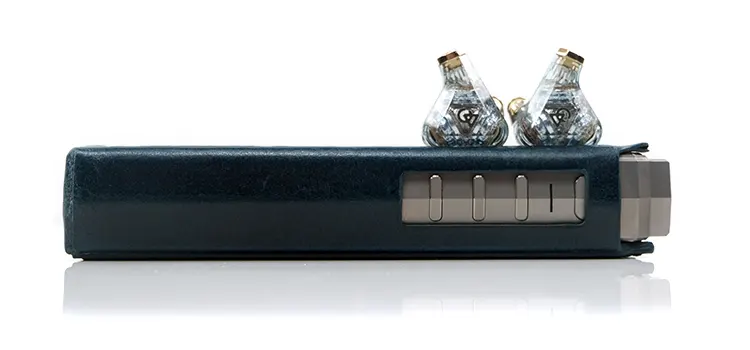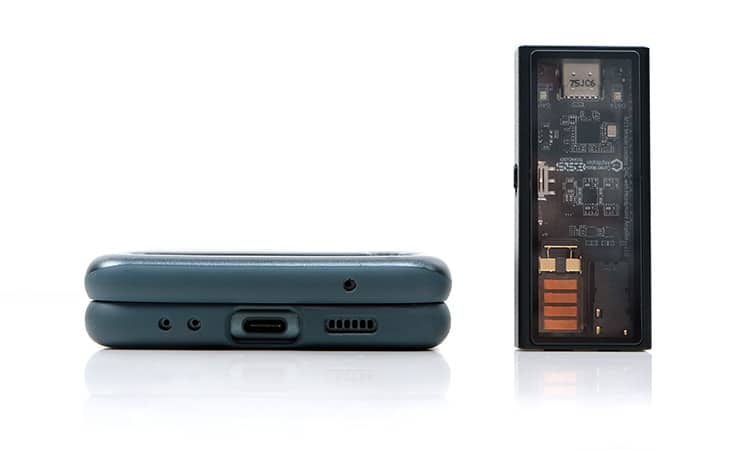Sound Impressions
The following sound impressions were compiled using the iBasso DX320 MAX Ti and the HiBy RS8 balanced output in low gain as the main sources.
Summary
The Campfire Audio Trifecta has a thunderous bass intense and high-energy sound signature. If you are a basshead then look no further. I honestly cannot think of an IEM that delivers such a concussive low-end performance.
Granted, the ‘uber-basshead’ Legend EVO from Empire Ears reaches as deep, probably as fulsome if not more so, but it’s that sledgehammer-in-your-face approach that makes the Trifecta equivalent hit so differently.
Unsurprisingly, a lot of the mids take second position behind the Trifecta bass response when the energy on the lows is at its maximum. However, a crafty little 1-2k peak ensures that at times, the Trifecta vocal presence is good and very analog in tone with a nice, albeit slightly rounded, textured quality to each note.
It is quite a contrast to the more widely used mix of BA and dynamic from competing high-end monitors. You will not get that ‘slice and dice’ level of separation, or the minute nuanced micro-detail in a quickened pace through the mids and highs.
Instead, you get note solidity, a very expansive staging quality, and a switch to macro-dynamics, emphasizing power and teasing out the emotion and tension of the song. So, whilst the Trifecta will not appeal to the purists, it does offer a unique addictive quality with certain genres.
The sparser the mix, the more ambient the music, and the more in touch with certain vocal performances, the better the pairing with the Trifecta becomes. For me, that means Synth Wave, modern R’n’B, and EDM. All these genres emphasize those key touch points I mentioned at the outset.
Tips
Tips make a big difference in the performance of the Trifecta and I do suggest you try a few before forming any long-term impressions.
The supplied foam tips are a bit muddy for me and increase the decay on the bass giving it a sloppier and slightly detached listening experience. If you start with them and are non-too impressed or pair it with an equally warm-sounding source I can empathize with your concern.
The silicone wide bore tips, on the other hand, are the preferred stock tips with an airier more engaging presentation and a tighter cleaner sound in general.
You can vary it also with the likes of Final E if you want to ramp up the bass weight even further. It’s hellish fun, but it can overwhelm the rest of the FR in the process giving it a very lopsided performance.
Frequency Response
If you are a Harman Target devotee then look away now as the Trifecta follows its own unique path. This is a modern V-shaped response curve with a huge level of elevation with plenty of bass right up to 100Hz then, a concerted drop to its lowest point at 1k.
It doesn’t remain flat through the mids, hence the word ‘modern’ in my previous paragraph. The Trifecta FR has a narrow but strong peak at 1-2k with dips on either side that can tease out some beautiful analog overtones and presence in vocals that pitch at that marker.
If they do not hit that pitch they can either be overwhelmed by the Trifecta’s bass presence or can drop back in the mix decidedly behind the vocals if pitching higher.
You do get a healthy injection of treble overtones with a stronger rise at both 5k and again at 7-9k. However, this rarely translated into spikiness or overly emphasized sibilance further down, an aspect I suspect that the 3-4k dip is there to prevent but it does mean percussion also sits further back imaging-wise.
Timbre
The Trifecta is neutral to natural with more of an analog overtone, a longish decay, especially on the lows, and a firm bass fundamental quality to notes throughout.
The coherence of the timbre is spot on given all 3 drivers are of the same type. However, the coloration of the Trifecta can shift a bit depending on the source and tip being used.
With the wide-bore silicone tips, you get a much cleaner tone from the Trifecta compared to the foam tips. One that I think greatly benefits the mids to highs performance and keeps the bass impactful and dynamic. They also produce some of the most seductive kick drum and bass guitar slaps or twangs I have heard to date.
The foam tips warm up the timbre a bit too much and suck out a lot of the treble presence giving the mids a very indistinct muddy tone that robs vocals of comparative energy and clarity.
You want that 1-2k bump to shine through, especially with more complex tracks with a lot of lower-midrange guitar work or even lower register notes that carry a huge high-energy fundamental. Vocals can peak and sound firm with excellent texture and girth but with the foam tips this becomes too soft so stick with silicone if you can.
Even with the silicone tips, the Trifecta can shift with sources. I ran it through quite a number of sources and one consistent theme was to try to avoid anything overly warm to keep those slower-sounding dynamic drivers from blooming too much or sounding too soft on the lows.
Sources like the iBasso DX320 MAX Ti and the HiBy RS8 introduce a more tonally neutral response from the Trifecta with the MAX probably the most dynamic and resolving but slightly less bass richness.
Staging & Dynamics
On a macro level and using the silicone tips, the Trifecta staging is deep reaching and grandiose in its presentation.
It generates incredible power with one of the most addictive fundamentals in an IEM I have encountered to date. The mid-bass punch is just as forceful if not more so than the sub-bass, producing an almost tactile feeling in your eardrum.
This is where your ear will be drawn for the majority of your listening time. It is hard to avoid those lows, particularly on bass guitar. I do not think I have ever heard an IEM so successful in teasing out such a ‘swinging’ bass guitar slap presence from Red Hot Chili Pepper recordings as the Trifecta.
However, the Trifecta is also relatively dipped in the mids with that narrow band 1-2k peak pushing some vocals forward with some welcome presence but not always. Such is the power and dominance of the lows it can still drive down the vocal imaging to well south of neutral.
That will be perfect with some genres such as EDM or house where beat-driven and higher-register vocals take prominence such as FKA Twigs or Jack Malone. More complex arrangements for vocal-centric lovers might want more of a 1-4k wide band boost.
Treble here is deceptive and I do mention this in relation to what you might see in some measurements or by using the foam tips. The presence and reach are good but not quite to EST driver levels for sparkle and articulation. Stick to the silicone tips also, they give the most natural treble tonal quality and the best headroom.
Synergy
Efficiency
The Campfire Audio Trifecta is rated at a fairly light impedance rating of 6.8Ω but with their own benchmarking system for SPL set at Vrms required to hit 94 dB @1kHz.
In this instance, the Trifecta is rated at 16.91 mVrms which stacks up quite well compared to the Vega 2020 rating of 19.86 mVrms. You have to remember the trifecta is using 3 10mm A.D.L.C drivers as opposed to one inside the Vega 2020.
It does require more mVrms than their more efficient BA driver monitors such as the Andromeda 2020 which is rated at 7.01 mVrms and Ara at 7.094mVrms Ara and compared to the 6.54mVrms Solaris 2020 it’s going to need more voltage also.
However, it really is not that hard of an IEM to drive from DAPs and dongles. Compared to multiple dynamic driver IEMs such as the Dmagic 3D, and the Vision Ears EXT on low gain balanced outputs from the likes of the Cayin N7 and the HiBy RS8, the Trifecta is surprisingly more efficient.
Pairing Preferences
The quality and timbre of the bass are really going to drive your pairing choices with the Trifecta. From there, I tended to look to just how well my source kept the mids neutral to natural in tone and not too soft and then finally good extension and air but nothing overly harsh sounding.
I tested 5 DAPs, 3 dongles, and the Cayin C9 to get a sense of the potential for the Trifecta to scale given how well the old Vega dynamic driver could power up with some serious juice.
DAP Pairings
From the DAP lineup, the HiBy RS8 and the iBasso DX320 MAX Ti came out as either the meatiest on the lows from the HiBy RS8 Turbo mode balanced output or the most dynamic and resolving, i.e. the DX320 MAX Ti.
The drawbacks are a little too much midrange neutrality from the RS8 in terms of image positioning and a stronger mids-to-treble presence from the DX320 MAX Ti. Some might argue that the neutral emphasis though will work better to balance out the lows and indeed they are both very good for clarity.
The Cayin N8ii offered a smoother more forward vocal presence than the RS8 but I felt the lows were a little softer and did not quite have the same impact as the RS8, even when the P+ mode was active.
Both the FiiO M15s and the Cayin N7 pairings brought a thicker tone, however, the M15s offered a more intimate soundstage whilst the N7 kept everything more spacious which I much prefer with the Trifecta.
The Cayin C9 retained a fairly analog and natural tone, more so with the tube mode but again I just wanted to keep things a bit clean and not so wet with the Trifecta drivers so I kept it in solid state mode. Class A was the better mode to my ears, with excellent dynamic range as well as giving the Trifecta vocals a bit of a lift and the treble fairly smooth.
Dongle Pairings
Hands down the Questyle M15 brought the goods when it comes to the Trifecta’s bass dynamics and clarity. This pairing will sound cleaner than the Cayin RU6 or the HiBy FC6 on the highs, and a bit livelier also so if you to tone the treble down then it might not be the best option.
The FC6 retains a nice level of bass thickness but is not quite as airy and dynamic as the M15 but definitely smoother through the Trifecta mids and highs.
The RU6 will soften the Trifecta lows a little, tease out a bit more vocal presence and sweetness but also keep the highs presence more than the FC6 though not as hard-edged as the M15.






